One of the most intriguing aspects of Grade II* Cobham Dairy (1796) is the slate cladding used by James Wyatt as part of his design. In recent years we’ve only known the Dairy as a (pretty enough) red brick building. This will soon be transformed by Landmark’s reinstatement of the slate coating into a gleaming eye-catcher that, from a distance, will look like stone.
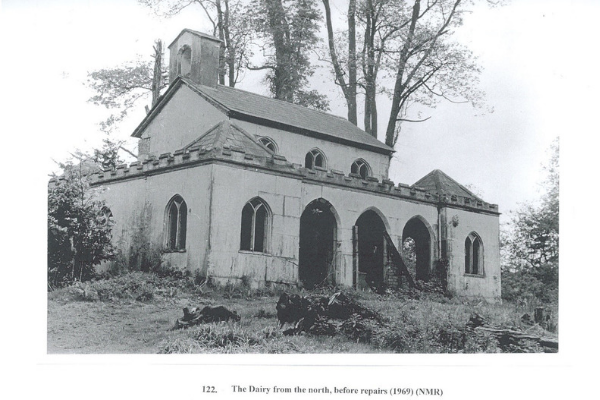
Cobham Dairy in 1969, with its slate cladding still intact. In the 1980s, a SPAB working party oversaw the slates’ removal and storage.
The 18th century was a period of great innovation and experimentation in building technologies, few of them long-lived. One of them was so-called ‘patented slates’, a term that became to be used generically to describe laying slates butt-jointed, meaning placed up to, rather than overlapping, each other.
Charles Rawlinson of Lostwithiel, Cornwall was granted a patent for a New Invented Method of Covering Roofs with Slates in 1772. Rawlinson had realised that the amount of slate needed to provide a weatherproof covering could be reduced by 50%, provided the joints between them were properly sealed. This was done by bedding slate strips in a ‘mastic’ or glaziers putty between the single lapped slates. Although such techniques were already in use on vernacular buildings in areas where riven stone roof tiles were in use, slate was becoming increasingly ubiquitous and patented slate roofs became a quite a popular technique.
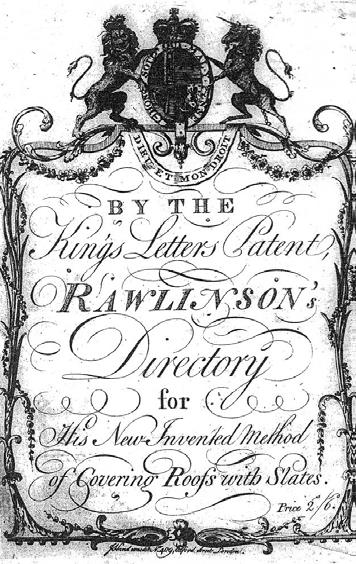
Frontispiece advertising Rawlinson’s Letters Patent in 1772.
However, subsequent lack of maintenance of the bedding putty led to the failure of almost all these roofs. Just a handful of examples survive, and even fewer survive for use of butt-joined slates as wall cladding.
Architect James Wyatt (1746-1813) was a great fan of patented slates. He also had a vested family interest in developing the use of slate in general. Wyatt’s brother Benjamin (d.1818) was the agent for Lord Penryhn in North Wales, and from 1786 managed the Penrhyn slate quarries. And so the Wyatts began to experiment with slate cladding on walls as well as roofs, finished with a sanded oil paint to imitate stone.
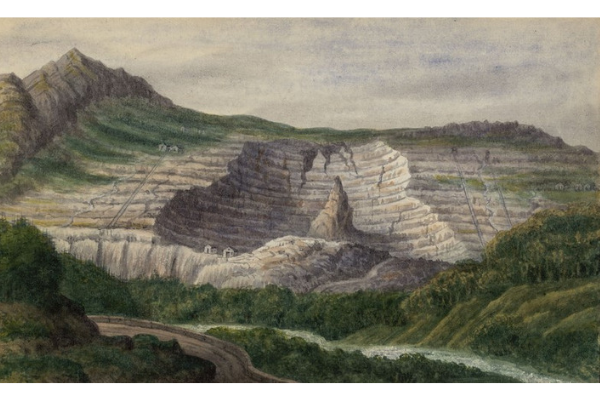
The Penrhyn Slate Quarries were among the largest in Wales, transforming the landscape as thousands of tons were quarried and sent across Britain.
An early trial was on the back of a parapet at Shugborough Hall in Staffordshire. Then in the 1790s, industrialist Matthew Boulton commissioned James Wyatt to extend his home, Soho House in Handsworth. Wyatt’s plans included cladding the new principal elevation in butt-jointed slates, painted in imitation of ashlar. Miraculously, this has been maintained throughout and survives beautifully intact to this day, impossible to distinguish from stone unless under the closest inspection. Recent maintenance campaigns there have been invaluable in informing our specifications for Cobham Dairy, and papers in the Boulton archives have thrown light on how Wyatt’s workmen refined the technique and the material used. There is even an 18th-century recipe for the bedding mastic.
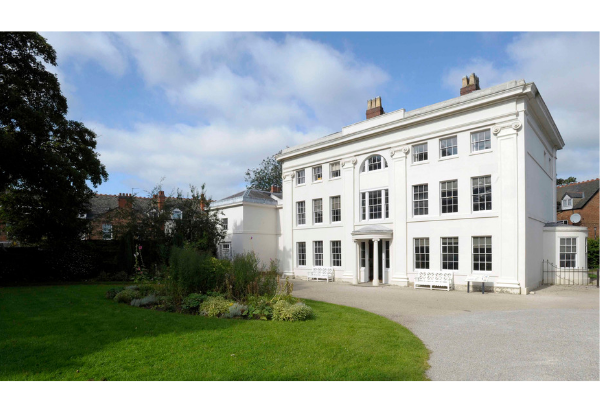 Matthew Boulton’s Soho House in Handsworth, Birmingham (now a museum) is the best surviving example of James Wyatt’s use of slate cladding. Even up close, it is hard to tell that it is not ashlar. The fixings have each been covered with a tiny plug of slate, and the whole is painted in a sanded oil paint.
Matthew Boulton’s Soho House in Handsworth, Birmingham (now a museum) is the best surviving example of James Wyatt’s use of slate cladding. Even up close, it is hard to tell that it is not ashlar. The fixings have each been covered with a tiny plug of slate, and the whole is painted in a sanded oil paint.
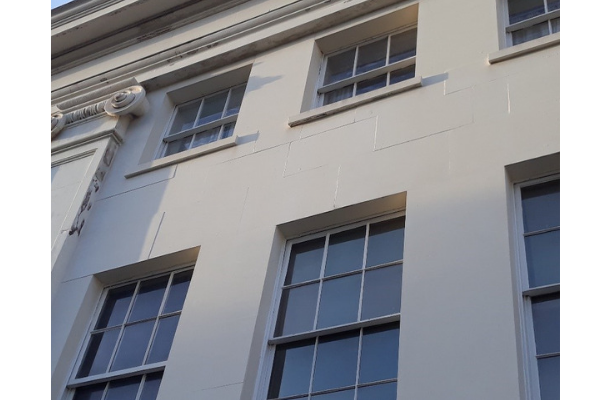
Unlike Soho House, Cobham Dairy had of course stood empty for decades. The paint had entirely weathered away and many of the slates had fallen. In the 1980s, our landlords, Cobham Hall School, carefully stored the remaining salvageable slates. Only some slates on the sheltered west elevation and a few shaped fragments in the reveals around the arcade arches in the cloisters were left, evidence of the high level of craftsmanship involved in the technique. We found that Wyatt had used a mixture of Penrhyn and Ffestiniog slates: the variation in colour did not matter, of course, because of the final, stone-coloured paint finish, traces of which still clung on.
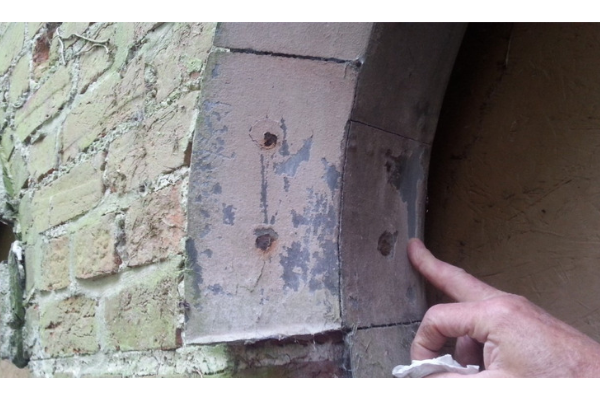
An example of the shaped slate slips in a window reveal. The rusting of the iron nails no doubt hastened the detaching of the slates once lack of maintenance took hold. The core brickwork behind is quite crude work – no need for a higher finish, given the slate cladding.
Landmark has now retrieved those salvaged tiles and it has been like a giant jigsaw puzzle to re-use as many as we can. Replacements have been ordered from Welsh Slate, based at Penrhyn: as in the 18th century, any colour variation does not matter as we are also reinstating the sanded paint finish. With long term maintenance in mind, we are using resin plugs to conceal stainless steel fixings, but the end result will once again look just as James Wyatt and Elizabeth, Countess of Darnley, originally intended in 1795 for this prettiest of model dairies.
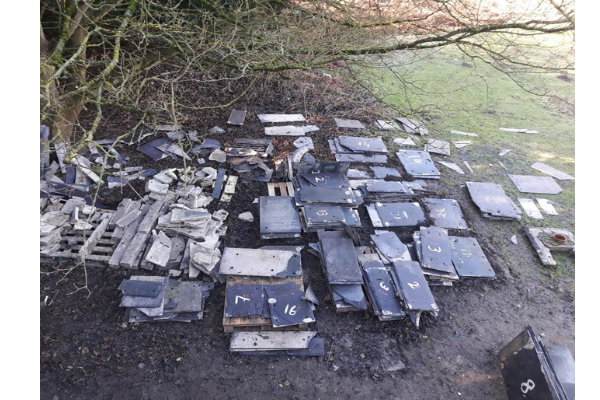
The salvaged slates all laid out beside the Dairy ready for re-use (February 2019)
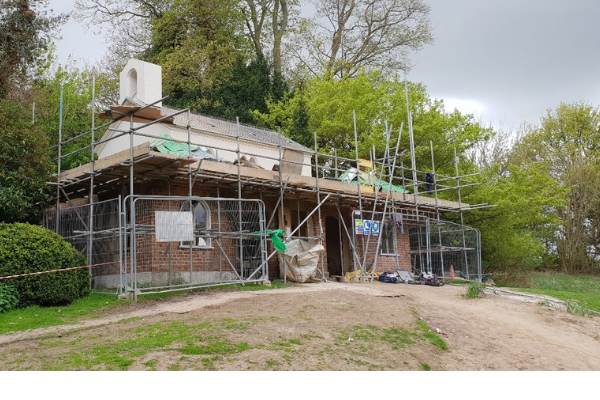
Work in progress, April 2019: the upper storey newly clad in painted slate.
With thanks to specialist insurers, Ecclesiastical for their support during the Cobham Dairy project.
